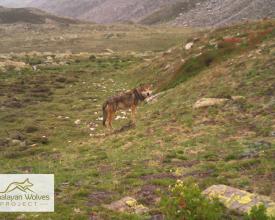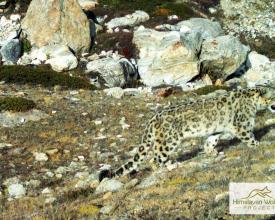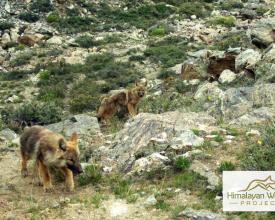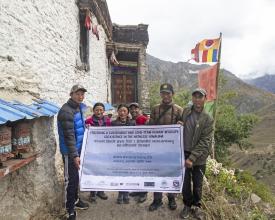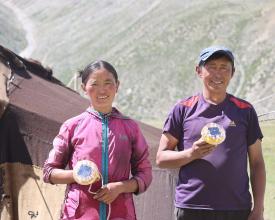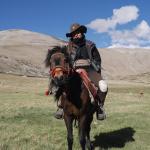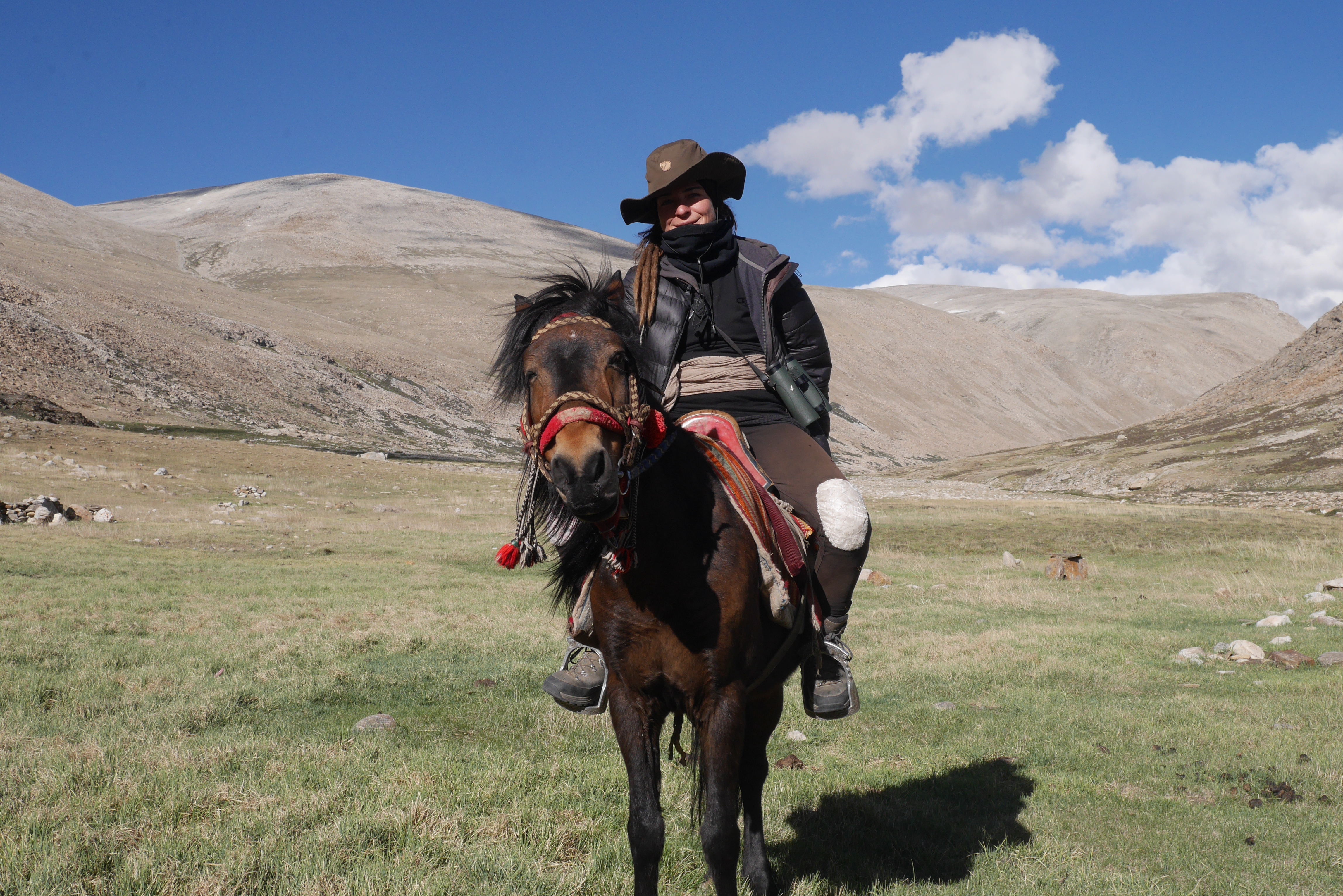
Himalayan wolf conservation. Human-carnivore conflict mitigation to support traditional Tibetan mountain communities face global warming
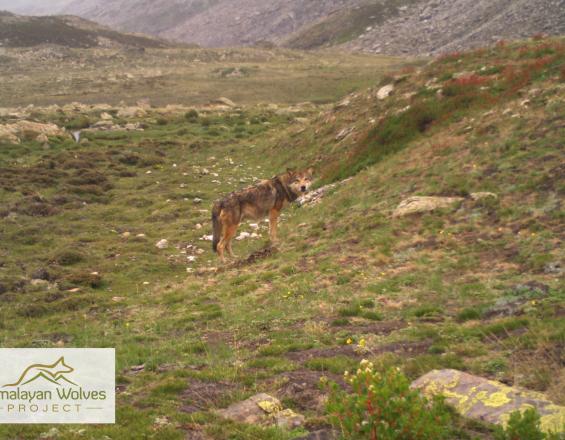
Carnivores are among the most endangered species. The loss of apex predators jeopardizes global biodiversity. The Himalayan wolf (Canis lupus chanco) inhabits ecosystems highly vulnerable to climate change. The survival of the Himalayan wolf depends on human-carnivore coexistence and the systems ability to adapt to climate change impacts on the Himalayan ecosystem.
Our Solution aims to improve the livelihood of local Tibetan communities and promote human-carnivore coexistence. We achieve this through scientific research in collaboration with locals; forming Community Conservation Groups (CCG); building communal predator-proof livestock corrals (co-funded by the local communities), piloting fox lights, conducting conservation workshops for herders, women, and school children and installing mini-libraries in local schools. This Solution for fostering human-carnivore coexistence in the high Himalayas is part of an ongoing long-term science and conservation project, the Himalayan Wolves Project (www.himalayanwolvesproject.org).
Context
Challenges addressed
Our solution addresses the challenge of providing scientific knowledge to global and local communities in Upper Humla. Rising temperatures are disrupting water distribution, causing floods, droughts, vegetation shifts, soil instability, threatening biodiversity and the economic sustainability of local livelihoods. A lack of access to monitoring technologies and research further hampers adaptation to these changes.
Limited infrastructure and economic opportunities in these high Himalayan regions have resulted in the decline of traditional livelihoods such as livestock herding and agriculture. This trend has triggered increased migration to urban areas, leaving villages and monasteries increasingly abandoned and eroding the cultural fabric of these communities.
A key challenge is fostering human-wild carnivore coexistence and promoting local stewardship of wildlife conservation. Building awareness and creating educational opportunities are essential to address the threats to livelihoods and biodiversity in this fragile region.
Location
Process
Summary of the process
The building blocks—Technology Deployment and Field Monitoring, Capacity Building through Community Conservation Groups (CCG), and Livestock Protection Infrastructure Building—work together by integrating scientific research and local community engagement to enhance Himalayan wolf conservation.
Scientific data from camera traps in Block 1 informs both connectivity models and conflict mitigation strategies. This evidence-based approach also guides the implementation of protective infrastructure in Block 3, where local communities co-fund and maintain predator-proof corrals and other deterrents.
The second block, through the creation of CCG, builds local capacity by training community members in species monitoring and conservation practices, ensuring that knowledge is passed down and effectively applied. The communities’ active participation enhances conservation outcomes and also strengthens their commitment to maintaining the infrastructure in Block 3. This integration of scientific research and community involvement creates a positive feedback loop, where economic benefits and knowledge sharing reinforce each other. Ultimately, these interconnected efforts promote coexistence between humans and wolves while building resilience for climate change.
Building Blocks
Technology deployment and field monitoring
The research on Himalayan wolf ecological requirements to face the climate crisis is based on camera trap data collected in the field in Limi valley of upper Humla (Nepal) from 2021 and 2023. 61 Cameras were powered by batteries and information was stored in SD cards. SD cards were collected by local collaborators who were trained specifically on these management tasks. After delivery, data was deposited in a cloud storage and camera trap data was processed using Traptagger, Wild eye AI technology. Local collaborators were equipped with GPS devices to register events and handle camera trap management. With this block we address GBF targets 1, 2, 3, 4, 8, and 9. Targets 13 and 14 have already been reached through scientific output describing the uniqueness of Himalayan wolf genetic identity. (Werhahn 2018, Werhahn 2020).
Enabling factors
The determinant factor to successfully achieve our goals in this block is to account with technology to monitor wolf populations (GPS devices and camera traps).
The second success key will be the participation of local communities who possess traditional knowledge of the study area helping us in selecting best places to place them, keeping the camera traps working, and safe from theft, and maximizing the camera traps performance.
Securing research permits is a mandatory factor that needs to be addressed with care.
Lesson learned
The technical simplicity of camera trap deployment encounters the logistic complexity of working in one of the remotest areas in the Himalayan range. The support by local communities is capital to the success of the block. Understanding the routes that herders use with their livestock is essential to prevent human interaction with cameras, wolves activity cores, and depredation sites.
Camera trap deployment has to be useful for spatial modelling but also has to account for optimizing wolf detections. Therefore, it is important to be flexible with analysis model requirements to account for the ground realities of high mountain carnivore field research.
Camera trap maintenance has to be done regularly. The fact of including local trained members in our team improves the logistics of this periodicity, increases the engagement in conservation values, and produces a source of economic income for the participants.
Capacity Building through Community Conservation Groups (CCG)
The creation of Community Conservation Groups (CCG) has been fundamental in building local capacity for effective conservation of the Himalayan wolf. These groups are composed entirely of local residents who are trained to participate actively in monitoring and conservation activities. Periodic workshops have been conducted to provide training in species monitoring, data collection, and camera trap management. Through these workshops, local participants gain valuable skills that enable them to contribute to the long-term success of the conservation project.
Community engagement and knowledge transfer are done by periodical workshops and follow-up on monitoring results using an audiovisual presentation. No remote digital platform can be used by local communities so far as there is no internet connection in the territory. The use of biodiversity credits as financial support for this block is currently under study. With this block we address the GBF targets 20, 21 and 22.
Enabling factors
A key enabling factor is the active involvement of local residents in the creation and development of CCG. By providing training and ownership, these communities are empowered to become stewards of conservation efforts.
The workshops are tailored to meet local needs, and regular follow-ups ensure that knowledge is retained and applied effectively.
Additionally, the financial benefits generated through their participation in the project foster greater commitment.
Regular workshops and educational outreach, including the creation of the children’s book The Web of Life: A Transhimalayan Animal Adventure and self-designed conservation games, increased awareness about the role of top predators in the ecosystem.
Lesson learned
- Not all community members are initially receptive to participating in conservation efforts. Cultural habits and easier short-term solutions are the first call for many families. Workshops and community engagement are essential to building support.
- The success of CCGs relies heavily on maintaining continuous engagement and adapting training programs to local realities. Establishing trust and ensuring that the community sees tangible benefits from their involvement are crucial for sustaining long-term participation. Regular communication and capacity-building efforts are essential to maintaining momentum and ensuring the success of the conservation plan.
- Building a balanced relationship with local communities required an open, judgment-free approach that respected their cultural uniqueness and avoided imposing moral perspectives beforehand.
Livestock protection infrastructure building
To address human-carnivore conflict, a range of protective measures were implemented in three villages of Limi Valley, Humla, Nepal, with the active involvement of local communities. These measures were designed to protect livestock from depredation by wolves and snow leopards, ensuring the safety of both local livelihoods and wildlife conservation efforts. Key actions include:
- Commitment to Zero Poaching Policy: Local villagers were engaged to establish a strong commitment to a zero-poaching policy, fostering a collective responsibility for wildlife protection.
- Construction of Communal Predator-Proof Night Corrals: Villagers collaborated to build sturdy, predator-proof corrals where livestock could be safely kept at night, reducing the risk of depredation.
- Distribution of Predator-Deterring Foxlights: Foxlights, an effective visual deterrent for predators, were distributed to livestock herders, helping to prevent attacks on livestock by mimicking a human patrolling with lights at night.
- Co-funding and Maintenance Responsibilities: Villagers took on responsibilities for co-funding the construction of the corrals and ensuring their proper maintenance over time, strengthening their investment in the success of the conservation efforts.
These actions were designed not only to protect livestock but also to build a sense of ownership and responsibility within the local communities, ensuring the sustainability of the efforts. GBF targets 8 and 9.
Enabling factors
The success of this approach hinges on the commitment of local communities to the protection of both livestock and wildlife. By involving villagers in co-funding and maintaining the infrastructure, they become active partners in the conservation effort. This sense of ownership helps prevent neglect and fosters long-term support.
Lesson learned
- Local communities may initially resist conservation measures due to cultural habits or the allure of short-term solutions.
- The key to success lies in continuous long-tem engagement and demonstrating the practical benefits of the infrastructure.
- Building trust and providing incentives for long-term commitment are crucial. A follow-up program is necessary to monitor the effectiveness of the mitigation measures and adapt strategies based on community feedback.
- Funding resources are capital to ensure continuity, maintenance and effectiveness evaluation.
- We tried to conduct a post-intervention survey to account for an increase or decrease in people’s attitude towards carnivores. For this we provided a few selected locals with the survey forms. However they could not perform as expected. This presents a difficult reality. Stronger implication of Community Conservation Group and more solid information on human population structure will improve our knowledge of the population to be addressed and fill the gaps in our understanding of plan’s results.
- To monitor the impact of predator deterring measures, we will analyze the evolution of livestock loss reports to administrative officers for compensation.
Impacts
The Himalayan Wolves Project exceeded expectations in monitoring Himalayan wolf ecology and fostering coexistence in Upper Humla. 61 camera traps recorded over 190,000 images, identifying wolf occupancy patterns across a 325 km² area. This monitoring revealed critical insights: wolves frequently use high-altitude grazing areas. We identified the areas with high predicted occupancy and evaluated the detection probability all across the study area. Human disturbance and theft of the camera traps was detected, but this was minimized due to effective community collaboration. This data is being transposed to future climatic scenarios to identify key environmental features for Himalayan wolves and human settlements.
Key achievements include:
- Conflict Mitigation: Predator-proof corrals and fox lights strongly supported local herders in depredation conflict mitigation and we have received very positive feedback. However these mitigations need to be continued for a longer time period in order to detect changes in depredation trends.
- Behavioral Insights: Camera traps documented wolves and herders with their livestock using overlapping areas. This data informed on how wolves and herders coexist using the same geographic patches.
- Community Involvement: Community Conservation Groups now include 11 village members, who co-manage collective infrastructures maintenance refraining vulnerable livestock attacks by carnivores.
Beneficiaries
Beneficiaries are the traditional mountain communities, as well as the specialized high altitude wildlife community of the region including wolves, snow leopards, brown bears, lynx and Pallas's cat. Indirect beneficiaries: officials and decision makers.
Additionally, explain the scalability potential of your Solution. Can it be replicated or expanded to other regions or ecosystem?
The plan was from the start to test the possible solutions in Limi Valley of Upper Humla, Karnali, Nepal and refine them for this setting and thereafter to scale up and implement across a larger Himalayan range. We have now tested and refined the solutions and are soon ready to scale up across a larger region. The solution can be scaled up across the Nepalese high Himalayas with potential to also implement in the continuous Himalayan habitats of Bhutan and also the Indian Himalayas.
Global Biodiversity Framework (GBF)
Sustainable Development Goals
Story

The story of our project started when one of our team members was hiking the Himalayas and was asking local people casually about the wolves in the area. Local people would repeatedly say “Well they used to be here, but now they are not here anymore, you have to go higher up to find them!” So we did and ask the same question again, the answer remained the same higher up. We returned home without having found the wolves of the Himalayas, but with a heightened curiosity about them. Soon we learned that little was scientifically known about them, not to speak of any conservation activity for them. So we set out to find the wolves and do more research to understand them. More than a decade later we have revealed through our research that these wolves represent a highly specialized and unique high altitude wolf population with genetic adaptation to cope with the low oxygen levels in their high altitude habitats. Our project was instrumental in establishing the data to shed light on these wolves which has recently led to their first IUCN Red List assessment and advance conservation efforts for them.
Importantly, in all these years we have worked closely with the local traditional Tibetan mountain communities and we have learned a lot from them about coexisting with large carnivores and nature which is naturally embedded in their culture and religion. Now we aim to support the local traditional communities in maintaining their ancient culture and way of life while at the same time benefiting from the amenities of modern life , and cherishing and protecting the wildlife treasures they coexist with in their high-altitude environment.
Konchok Nguedup Lama, a livestock herder from Til village in Limi Valley, spends months tending to his yaks in the high pastures. In the past, he and his fellow herders would light fires near their camps at night to deter predators. On other occasions, they would wake in the middle of the night to make noise and scare predators away.
In November 2021, we provided predator-deterring fox lights to Konchok and his fellow herders. They were pleased to receive the lights, and when we returned to the area in September 2022, Konchok expressed profound gratitude. He remarked, “There hasn’t been any trouble with wolves or snow leopards since we started using the fox lights. On top of that, we now enjoy peaceful nights without having to make noise to scare predators. Interestingly, the yaks also enjoy peaceful, undisturbed nights."


